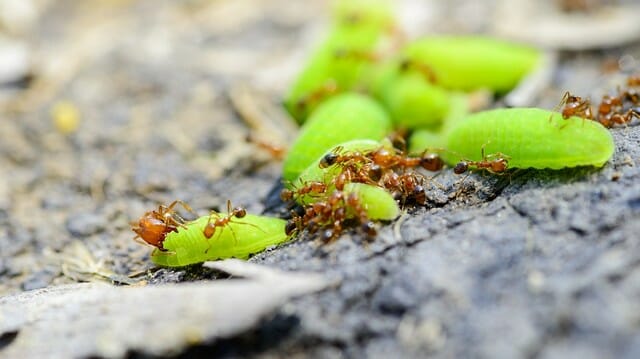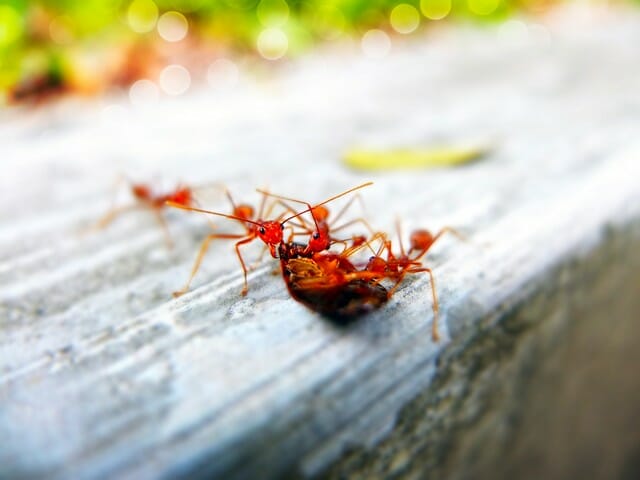Last Updated on November 25, 2021 by Grow with Bovees

Much as they’re a part of the ecosystem like Mother Nature intended them to be, there’s absolutely nothing harmless about fire ants. Found in 13 of America’s 52 states, these insects, mistakenly brought over from South America in the early 20th century, have definitely overstayed their welcome, causing a range of agricultural and medical problems with their aggressive attacking and repeated stinging.
Fire ants also cause disturbances in local ecosystems, destroying the nests of, well, pretty much anything they get their hands on—lizards, snakes, songbirds, rodents, toads and the like.
If you’re looking to get rid of a fire ant menace in your backyard (and by all means, you should!), here’s a breakdown on all things ‘fire ants’, including their behavior and how to get rid of them!
A Little Bit About Fire Ants
Fire ants thrive in dry, warm environments, which means they’re typically found in the Western, Southern, and Southwestern United States. Native to South America and accidentally introduced to the States, they can range between 0.125 and 0.25 inches in length, with a reddish black or brown body.

Like all other ants in the family, fire ants also live in colonies, with a very firmly established social hierarchy—queen (or queens), drones, worker ants, and reproductives. They build huge mounds of loose soil and will aggressively defend their territory, typically 18 inches highest above ground.
Don’t let the size of the mound fool you—these 18 inches are just the tip of the iceberg, with a buzz of activity happening underground in extensive tunnels. It doesn’t take too long for the mounds to multiply with available space, which is why it’s always advisable to cut off infestations as early as possible.
To put it into perspective, a single colony, spread over an acre, could comprise 500,000 ants and hundreds of mounds! Things also get more problematic when you realize that the mounds are not the first indication of a fire ant colony—by the time the mound is visible, the ants have already been there and multiplying for months.
Fire ants are also known to be attracted to electricity, capable of damaging transformers, heat pumps and air conditioners.
Fire Ant Behavior
It always helps to know your opponent’s moves—makes it that much easier to defeat said opponent!
Fire ants have a tendency to keep moving and migrating and they do it rapidly. They’re comfortable nesting in any type of soil, as long as the area is open and sunny. This makes any sunny garden, lawn, or any area where there’s space to build mounds and dig tunnels are fair game. Additionally, unlike other anthills, there is no entry to the nest through the mound.

You should bear in mind, as mentioned above, that by the time the mounds appear, the ants have already been at it. Also, mounds may not always appear—there could be a thriving colony where there’s no mound, too.
Another factor to bear in mind is that fire ants move quickly and react very quickly to any disturbance, raining fiery, venomous stings on any person or animal that is the cause behind the disruption. However, this reaction to disruption also extends to the underground tunnels. Fire ants can relocate quickly to other areas, seemingly building new kingdoms overnight!
Therefore, getting rid of these ants means getting rid of those above and below ground and well before they can relocate. As it is with a game of chess, defeating the queen means the battle almost won—queen ants can live for seven years or more, as opposed to the average five weeks of a worker ant, laying hundreds of eggs a day in this period. Killing the queen will kill the colony.
Additionally, fire ants are most active during the warm seasons, with mild weather and warm soil. During very hot and very cold days, they choose to stay underground. Mild weather is a motivator, so when these ants come out in the early mornings or evenings to source food, full-yard and mound treatments will work excellently. Be careful that you don’t park your car near a fire ant colony as you could end up with a fire ant infestation in your car, which is no laughing matter!
Methods of Getting Rid of Fire Ants
Baiting Fire Ant Mounds
Fire ant baits are excellent treatment methods, as ants, being social creatures, will take the bait, which they perceive as food, back to the colony and share it. Fire ant baits work extremely well both indoors and outdoors, there are many products available to kill fire ants.

Indoors
Place the bait in areas where you see ant activity or spots that may attract ants, such as kitchen cabinets, drains, the refrigerator, stove and so on. Wall openings are also a good spot to place baits. Ensure that you don’t place them directly on the trail, though, as the ants are smart enough to recognize a trap.
Outdoors Broadcasting Method
If you’re baiting ants outside, you can either use the broadcast baiting or mound baiting method. Ant baits are generally granular insecticides that can kill the ants or work as birth control or both.
If you’re broadcasting baits, which means full yard bait treatment, use a broadcast spreader to apply the granules on the infested areas. Don’t disturb the colonies for several days, as this allows the workers enough and more time to take the bait back to the nest and have it work its magic.
If you’re only baiting the mounds, apply the bait around the mound and not directly on it, as recommended by the manufacturer. Again, allow several days for the bait to sufficiently work.
Remember, when you’re baiting, keep all pets and children away from the infested areas. Additionally, for best results, apply the bait on a day when you’re not planning to water the lawn or there’s no rain forecast for the next 48 hours. If the day is extremely hot, wait till the ants come out in the early morning or evening.
Over’n Out!® Advanced Fire Ant Killer
You can spread some of this product, which is made by the same people who make the best-selling Sevin dust. This will kill them in short order, use on the mounds, anywhere you see them.
Fire Ant Control Sprays
Fire ant sprays are commonly available and can be used as a two-step method in conjunction with baiting for effective treatment — baits may not work if the ants already have an established source of food. Non-repellent fire ant sprays are great, since they don’t give off an odor. Ants will walk through the sprayed areas without so much as a clue, with the spray’s molecules attaching to their bodies and eventually making their way into the ant nest.

Apply the spray around all openings and crevices for effective treatment.
Mound Drenches For Heavy Infestations
The mound drench method is your best bet when you need to get rid of individual colonies. You can drench the mound either with a liquid insecticide, using ant insecticide solution, or granules, with granular insecticide.
If you’re using a liquid, spray a circle of it around the mound and allow it to dry. After it has, poke a hole through the top of the mound and pour the liquid into the mound as well. If you’re using granular insecticide, apply the insecticide at least three feet away from the mound and on top of the mound, pouring water on the mound to soak in the granules. All insecticides come with their own instructions, so be sure to factor those in, too.
Natural Methods
Some folks swear by natural methods to get rid of fire ants, such as dish soap, diatomaceous earth, boiling water, white vinegar, cayenne pepper, peppermint, baking soda, and the like.

Diatomaceous earth, a type of silica, kills ants by drying out their skeletons—it sucks the oil out of their bones. Remember not to use this near food preparation areas, though. White vinegar can be used as a spray—the smell throws ants off their trails, this also helps to get rid of sugar ants. Use the spray on counters and other hard-to-reach areas. You can either leave it there to dry or wipe it up after a few minutes. These natural methods also work to get rid of ants of most types.
The Bottom Line Of How To Get Rid Of Fire Ants
Fire ants can be a nuisance and an especially painful one at that. There are many methods of red imported fire ant control, though, both natural and otherwise.
There are also many over-the-counter treatments available to battle fire ant infestations and based on your preferences (and the efficiency of the product!) you can pick one out to battle your fire ant woes. Good luck!
